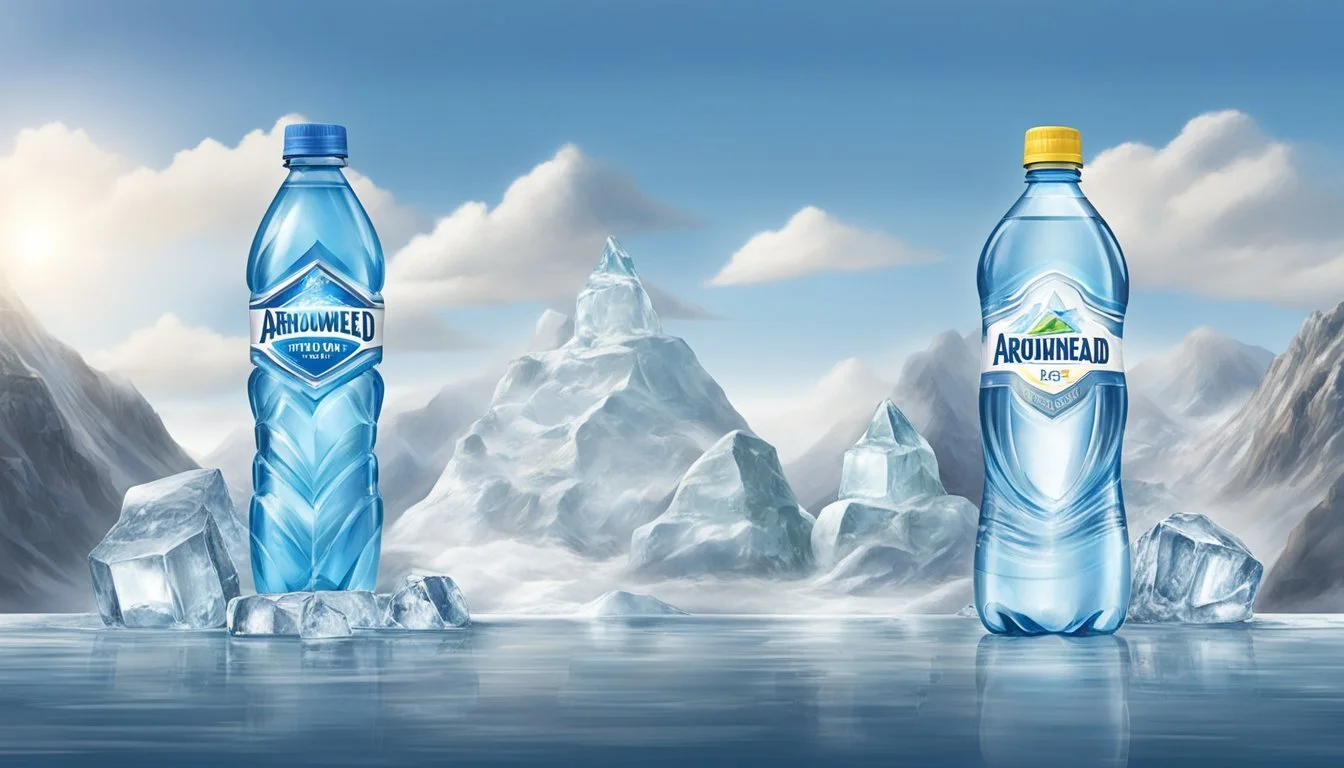Arrowhead vs. Ice Mountain
Comparing Quality and Taste in Bottled Water
When it comes to choosing bottled water, consumers may find themselves weighing the merits of Arrowhead versus Ice Mountain. Both brands are well-known in the bottled water market, and each has its own following. Arrowhead, which sources its water from multiple springs in the western United States, has been a staple on the West Coast for many years. Ice Mountain, on the other hand, claims Midwestern roots and prides itself on offering a crisp taste that many find superior to other "standard" bottled water options.
The differences between Arrowhead and Ice Mountain extend beyond regional sources. The taste, purity, and overall brand reputation play significant roles in a consumer's choice. While some may have concerns about the presence of additives or the way the water is processed, others may prioritize the brand's environmental impact, considering factors such as how long it takes for the bottles to biodegrade.
In comparing Arrowhead and Ice Mountain, it is important to scrutinize the specifics: the sources of the water, the bottling process, the taste profile, and the brands' commitments to environmental sustainability. Each brand's offerings reflect a unique set of qualities that cater to varied consumer preferences, complicating the choice between the two. This comparison seeks to distill the essential facts, helping consumers make an informed decision based on the most relevant and accurate attributes of each bottled water brand.
Historical Overview and Brands
In assessing the journey of Arrowhead and Ice Mountain, it is essential to understand the shift from tap water to bottled water and the rich histories each brand brings to the consumer market.
Origins of Bottled Water
The commodification of bottled water began in the 17th century, though its consumption dates back to ancient times. Early on, bottled water was sourced from natural springs and consumed for its purported health benefits. As urbanization increased, the demand for clean drinking water gave rise to widespread bottled water consumption.
Evolving Preferences: From Tap to Bottled Water
Over time, concerns about the quality of tap water, alongside the rising convenience and marketing of bottled water, led to a significant shift in consumer preferences. Many individuals now opt for bottled waters, believing them to be a safer and more consistent alternative to municipal tap water.
Arrowhead and Ice Mountain: Brand Histories
Arrowhead Mountain Spring Water, with roots in the western United States, derives its water from 13 springs located primarily in the mountainous regions, offering what many consumers perceive as a fresh and pure taste. The brand’s history can be traced back to the merger in 1929 that formed the California Consolidated Water Co., which expanded the production and distribution of Arrowhead Water.
Ice Mountain Natural Spring Water is known for its Midwestern origins. The brand asserts superiority in the taste and quality of its water, attributing it to the brand's selection of regional springs, which purportedly endow it with a crisp flavor profile.
Both Arrowhead and Ice Mountain have managed to carve distinct identities, supported by their regional origins and customer loyalty built upon their historical presence in the bottled water market.
Product Analysis
In this analysis, Arrowhead and Ice Mountain bottled waters are evaluated based on their sources, quality, mineral content, taste, and potential health implications. These key elements will inform consumers about the differences and similarities between the two brands.
Arrowhead's Water Source and Quality
Arrowhead sources its water from multiple springs located in the mountains of the western United States. The brand prides itself on providing 100% mountain spring water. They conduct rigorous quality tests and provide quality reports to ensure their water meets FDA standards. The pH levels of Arrowhead water typically range, supporting a neutral taste profile.
Ice Mountain's Water Source and Quality
Ice Mountain obtains its water from several natural springs in the heart of the Midwest, mainly Michigan. Much like Arrowhead, Ice Mountain emphasizes the natural origin of its water and adheres to stringent testing. Their quality reports are easily accessible for consumers seeking verification of the water's purity. Ice Mountain's water also aims to maintain a balanced pH level, which is a significant factor in its fresh taste.
Comparison of Mineral Content and Taste
Arrowhead:
Mineral Content: Contains minerals such as calcium, magnesium, and potassium.
Taste: Generally characterized as crisp and fresh with a neutral to slightly alkaline taste.
Ice Mountain:
Mineral Content: Features a similar array of minerals, which contribute to its signature taste.
Taste: Often described as clean and well-balanced, with a natural flavor profile.
Both brands offer mineral water that provides distinctive tastes and health benefits associated with their mineral content. Consumers may perceive the taste differently, as individual preferences vary.
Health Implications of Consumption
When it comes to health, both Arrowhead and Ice Mountain bottled waters are considered safe to drink, complying with federal and state regulations. The mineral content of the water can contribute to an individual's daily mineral intake. However, as with all bottled water, consumers should remain conscious of the environmental impact of plastic bottles and consider the source and quality of the water they choose to drink.
Manufacturing and Packaging
In the competitive bottled water industry, both Arrowhead and Ice Mountain emphasize their commitment to sustainable practices in manufacturing and packaging, albeit with varying approaches.
Bottle Materials and Environmental Impact
Arrowhead and Ice Mountain use plastic bottles for their water products. The plastics used are intended to be BPA-free, reducing potential health risks associated with bisphenol A. Concerning the environmental impact, both brands have faced scrutiny regarding plastic waste. Hence, they have taken steps to include recycled materials in their bottles. Ice Mountain, for instance, offers some products in plastic bottles that are made with up to 50% recycled plastic.
Production Processes
The production processes of Arrowhead and Ice Mountain involve stringent quality controls to ensure the purity and safety of the water. Arrowhead sources its water from mountain springs, while Ice Mountain's water is derived from underground springs. Both brands employ a multi-step purification process that includes filtration and ozonation, ensuring that the final product meets or exceeds government standards.
Sustainability Initiatives
When it comes to sustainability, both brands acknowledge the importance of reducing their environmental footprint. Arrowhead has initiatives to preserve the natural springs from which it sources its water, reflecting a commitment to environmental stewardship. Ice Mountain, on the other hand, is actively involved in watershed preservation programs to sustain the ecosystems surrounding their springs. Both brands undertake efforts to reduce emission in their production processes and invest in recycling programs to mitigate plastic waste. These initiatives demonstrate an ongoing effort to promote sustainability in the bottled water sector.
Safety and Regulations
Bottled water brands like Arrowhead and Ice Mountain are subject to stringent safety standards to ensure consumer health. Both companies must comply with federal regulations and conduct regular testing to monitor for contaminants.
FDA and EPA Standards Compliance
Both Arrowhead and Ice Mountain are required to meet the standards set forth by the Food and Drug Administration (FDA) and the Environmental Protection Agency (EPA). The FDA regulates bottled water as a food product, ensuring that it meets the same safety standards as tap water, which is regulated by the EPA. These standards govern levels of contaminants, such as heavy metals and PFAS chemicals, known to be potentially hazardous.
PFAS Chemicals: Per- and polyfluoroalkyl substances, which are not currently regulated by the FDA but are under environmental scrutiny.
Heavy Metals: Including lead and arsenic, which have maximum contaminant levels established by the FDA.
Quality Control and Testing
For quality assurance, both brands conduct regular testing of their water sources and finished products. This involves checking for the presence of contaminants like heavy metals, arsenic, and lead.
Ice Mountain: Employs a multi-barrier approach which includes sourcing, filtration, and packaging.
Arrowhead: Utilizes a quality control process that ensures the water complies with all health standards before distribution.
Reporting and Transparency
Transparency is key in the bottled water industry. Companies are required to provide quality reports to consumers, detailing the results of their testing.
Quality Reports: Arrowhead and Ice Mountain offer access to their water quality reports via their websites or customer service lines.
FDA Regulations: Mandate that these reports include information on the levels of any detected contaminants, such as arsenic or lead.
Both companies utilize these practices to not only comply with regulations but also to foster consumer trust through transparency about their product's safety.
Consumer Experience
In this section, the focus is on how consumers interact with Arrowhead and Ice Mountain bottled waters in terms of their availability, taste preference, and the trust they have in these brands.
Accessibility and Convenience
Arrowhead and Ice Mountain bottled waters are widely available across grocery stores, convenience shops, and online platforms, making them accessible to a broad consumer base. Arrowhead, sourced from springs in the mountains of Western United States, primarily caters to the regional market, while Ice Mountain, primarily sourced from the Midwestern United States, has a similar distribution footprint in its region.
Taste Test Results and Preferences
When evaluating hydration solutions, taste is a substantial factor. In a blind taste test, consumers might find a distinction between Arrowhead and Ice Mountain based on their respective flavor profiles. While subjective, Ice Mountain is often characterized by a taste that consumers describe as crisp, perhaps due to its higher mineral content. Arrowhead's flavor is often perceived as smooth, which some consumers prefer for regular hydration.
Brand Loyalty and Trust
The trust and loyalty consumers have towards a brand significantly influence their purchasing decisions. Ice Mountain, as part of the Nestlé family of products, shares its reputation, which may sway consumers. Arrowhead, also under the Nestlé banner, capitalizes on its image of sourcing from natural springs, which can be a deciding factor for those who value natural sources of hydration. Both brands have established trust with a segment of consumers who consistently choose their products over others.
Health and Wellness
Choosing the right bottled water is important for health and wellness. Factors like mineral content and purity can affect hydration, health risks, and the immune system.
Drinking Water and Hydration
Water is essential for maintaining hydration levels in the body. Both Arrowhead and Ice Mountain offer bottled water that can keep individuals adequately hydrated. Hydration is crucial as it plays a vital role in maintaining bodily functions, including regulation of temperature, joint lubrication, and nutrient transportation.
Potential Health Risks and Benefits
When considering bottled water, one should be aware of both its potential health risks and benefits:
Health Risks: Contaminants found in some bottled waters may pose health risks over time. It is important to ensure that bottled water, such as Arrowhead or Ice Mountain, meets safety standards and contains no harmful levels of substances like fluoride or BPA from plastic bottles.
Benefits: Arrowhead and Ice Mountain waters are typically free of calories, sugar, and artificial sweeteners, making them a healthier choice over sugary drinks, potentially reducing the risk of diabetes and other health conditions.
Impact on Immune System and Chronic Diseases
The immune system benefits from proper hydration as it relies on fluids to transport nutrients and signal cells. Chronic diseases, such as diabetes, can be managed with adequate water intake, which helps regulate blood sugar levels and kidney function. It is not explicitly stated that Arrowhead or Ice Mountain have particular effects on chronic diseases, but staying hydrated with any safe, clean water is beneficial for overall health.
Market Trends and Consumer Behaviour
In the competitive landscape of bottled water, Arrowhead and Ice Mountain emerge as prominent players. Their performance, however, is intrinsically linked to the overarching trends and preferences shaping the beverage industry.
Shifts in Beverage Consumption Habits
Consumers are increasingly opting for healthier alternatives to sugary drinks, with bottled water seeing a significant upswing in demand. The bottled water market has benefited as health-conscious consumers make more hydrating choices. Reports suggest a shift with people drinking less soda and more still and sparkling water. These habits are influencing how companies like Arrowhead and Ice Mountain position their products in the market.
Still Water Consumption: Regular still bottled water maintains a stronghold in the market.
Sparkling Water Rise: A notable rise in the preference for carbonated water has been observed.
Bottled Water vs. Carbonated and Flavored Waters
While still water remains a staple, carbonated and flavored waters are carving out their niche. Carbonated water offers the fizz of soda without the calories, appealing to those looking for a healthier effervescent alternative.
Carbonated Water Sales: Increased interest in carbonated options with a compound annual growth rate (CAGR) projecting positive trends.
Flavored Water Popularity: Flavored water is engaging consumers wanting variety without forfeiting the benefits of hydration.
Arrowhead and Ice Mountain must navigate these consumer trends, balancing the demand for pure, unadulterated still water with the growing appetite for carbonated and flavored varieties. The companies’ strategies in responding to these market dynamics may determine their respective standings among health-conscious buyers.
Environmental and Social Considerations
In comparing Arrowhead and Ice Mountain bottled waters, it's crucial to look beyond just taste and price. The environmental footprint and the companies' adherence to social responsibility play significant roles in the evaluation process.
The Environmental Impact of Bottled Water
Bottled water production involves various factors that may negatively affect the environment. For both Arrowhead and Ice Mountain, their parent company, Nestlé, has faced criticism over the years for their water sourcing methods and the resulting ecological impacts.
Environmental Impact:
Water Source Depletion: Extracting vast amounts of water from natural springs can lead to ecosystem damage and reduced water availability for local communities.
Plastic Usage: The manufacturing of plastic bottles generates significant pollution and contributes to the global issue of plastic waste.
Ice Mountain claims to engage in eco-friendlier practices by using less plastic in their Eco-Shape bottles, and both brands promise recycling initiatives.
Sustainable Practices:
Recycling programs
Lighter packaging to reduce material use
Social Responsibility and Ethical Practices
Social responsibility for bottled water companies also encompasses ethical sourcing and support for community initiatives. Starbucks' Ethos Water provides one example, where a portion of profits is dedicated to providing access to clean water in underprivileged areas.
Nestlé has established various programs and claims to commit to ethical water management but has also dealt with controversies regarding water rights and impacts on local communities.
Ethical Practices:
Community impact assessments
Engaging with local stakeholders for shared water management solutions
Future of Sustainable Bottled Water
Looking forward, the industry faces the challenge of aligning with EPA standards and global sustainability goals. Consumers increasingly favor brands that minimize their environmental footprint and contribute positively to society.
Nestlé has discussed increasing their use of renewable energy and improving water efficiency within their operations to address these concerns. Both Arrowhead and Ice Mountain will likely continue to innovate in their sustainability practices to meet evolving expectations.
Sustainability Goals:
Use of renewable energy sources
Improved water stewardship practices
Conclusion: The Verdict on Arrowhead vs. Ice Mountain
When evaluating Arrowhead and Ice Mountain bottled water, one must consider several factors such as taste, purity, and environmental impact.
Arrowhead water has faced scrutiny concerning its sourcing practices, particularly the extraction of water from springs in the San Bernardino Mountains. Critics have highlighted potential ecological repercussions and sustainability concerns.
On the other hand, Ice Mountain is known for its midwestern U.S. sourcing, and often promotes the regional origin of its water. Consumers may find Ice Mountain's taste to be neutral and palatable, a key factor in its popularity.
Aspect Arrowhead Ice Mountain Source San Bernardino Mountains springs Midwestern U.S. springs Sustainability Controversial extraction practices Less controversy Taste Average, with added minerals for taste Neutral, widely acceptable taste
The bottom line is that both brands offer certain benefits and have their drawbacks. Arrowhead's environmental controversies might concern some consumers, while Ice Mountain's regional appeal and less contentious sourcing could be deciding factors for others.
Ultimately, personal preference plays a considerable role in determining the better brand between Arrowhead and Ice Mountain. Consumers are encouraged to consider these points alongside their values and taste preferences when making a choice between the two brands.








